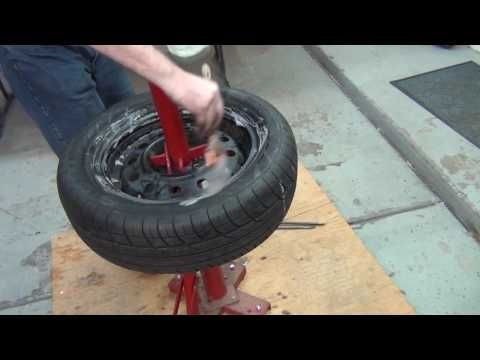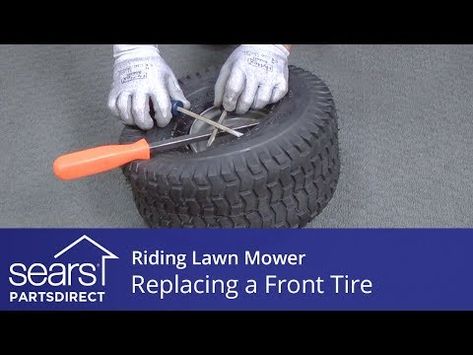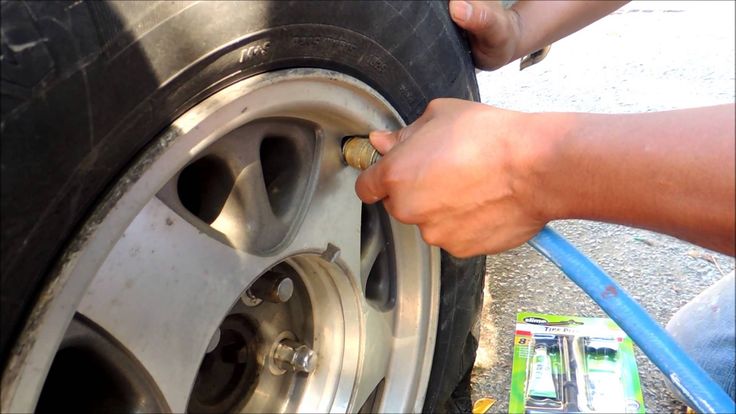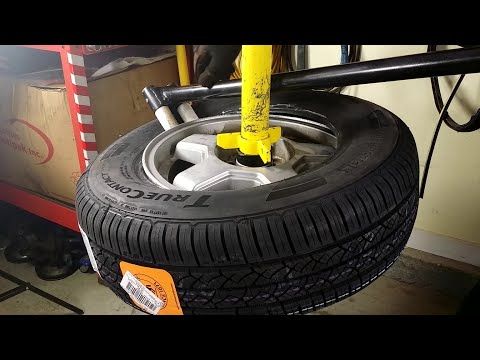Posted on
Tire mounting and demounting requires specific knowledge and tools. Only trained professionals should mount and demount tires. The Rubber Manufacturers Association has established guidelines for safe demounting and mounting which are available in manuals and wall charts often displayed in professional garages where these services are provided.
Tire technicians are trained to safely demount, mount and inflate tires according to the Rubber Manufacturers Association’s procedures.
Faulty mounting or demounting can cause a mechanical failure that can result in a traffic accident, potentially causing serious injury or death. Following the proper procedures and practicing safety is essential to minimizing risks.
Professionals should adhere to the following steps to demount and mount tires.
 The specifications are located in the driver’s manual or the inside of the driver’s side door jamb. Use an extension hose for air insertion. Never stand over a tire when inflating but stand back and away as far as you safely can.
The specifications are located in the driver’s manual or the inside of the driver’s side door jamb. Use an extension hose for air insertion. Never stand over a tire when inflating but stand back and away as far as you safely can.Find a Personal Injury Lawyer,
Near Me (855) 529-0269
The following cautions may help keep tire technicians and vehicle owners safe from tire mounting-related complications.

Proper tire mounting and demounting and inflation of your tires is essential to your safety while driving your vehicle. Do not attempt to mount or demount your tires yourself.
Seek a professional’s services instead. Be sure to ask any questions if you are unsure of a professional’s qualifications. If injured by someone else’s poor tire mounting or demounting practices, you may be entitled to compensation for damages.
Chalik and Chalik can help if you are injured from a tire failure or other tire-related problems. We’ll help explore liability for your accident; the tire manufacturer or a tire service professional may be liable in the event that you experience tire failure and a related accident. Call us today at 855-529-0269 to set up a free consultation to discuss your case with an attorney.
Call or text Chalik & Chalik (855) 529-0269
posted on: May 15, 2020 07:15 am
You need to have a practiced touch to accurately mount and dismount your tires if you hope to avoid damage. It takes more than sheer force to replace tires safely, and Bauer Built Tire & Service has you covered.
It takes more than sheer force to replace tires safely, and Bauer Built Tire & Service has you covered.
Never dismount tires while they’re inflated and avoid tools that will damage the sidewalls or tire beads. Lubricate the rim flange and tire beads to assist the removal process.
Lubricate Tire And Wheel ComponentsThere are plenty of moving parts during mounting and dismounting, and all that motion can take a toll on your tire and wheel components. Lubricating facilitates mounting, dismounting, and adjustments, so you won’t have to worry about punctures or tears.
Before fitting a new or existing tire back onto the wheel, lubricate:
Avoid any lubricant that will damage the tire like silicon or hydrocarbon-based products.
Properly Mounting TiresInspect the wheel and rim for damage, cracks or corrosion. Clean with a wire brush to remove flaked or excess paint, rust, and debris. Any irregularities will prevent the tire from laying flush once the clamping force is applied.
Clean with a wire brush to remove flaked or excess paint, rust, and debris. Any irregularities will prevent the tire from laying flush once the clamping force is applied.
Pay attention to the studs. If you replace a single damaged stud, you’ll need to replace the two studs adjacent to it as well. Two or more damaged studs require replacing all ten.
Position the wheel on the ground with the drop center facing upward. With the valve hole at the bottom of the wheel, line up the first bead is at the rim’s edge. Place the tire on the wheel with the proper tools, do not force it on with your knee or foot, and use a rocking motion to fit it properly.
Inflating Mounted TiresInflate the tire to 5 psi and check that the beads are positioned correctly. Your service technician should verify the correct inflation pressure with the tire manufacturer’s load. Tires must be placed in a cage during inflation as a safety measure. The tire will have to be deflated, removed, lubricated, and replaced if the beads do not sit correctly.
Inflate commercial truck tires to 20 psi to inspect that sidewall cords are good. Upon completing this inspection, over-inflate by 20 psi the manufacturer’s standard psi to confirm that there are no cracks in the sidewall cords. Then achieve the final manufacturer’s psi by deflating the air pressure until the correct psi is reached while not exceeding the air pressure recommendations of the wheel.
Bauer Built also offers a wheel reconditioning program to correct surface corrosion and rust found during our inspections and mounting and dismounting of tires for our commercial accounts. Contact us to learn more.
Categories: News, Tire Care Tips
0003Related materials
Tire inflation with nitrogen and 7 more wirings at the tire fitting
In the middle-end of autumn, car owners storm tire shops. However, you can disassemble the wheels yourself. We'll show you how to do it. We will need a special tool, as well as a screwdriver to unscrew the wheel valve, and a couple of pliers to help remove the tire from the rim.
To rid the rim of the tire, we bought a simple but very useful device - a mechanical wheel beader. There are several options on the market, but we chose the one produced by the Sorokin company. It is inexpensive. Thanks to the ability to adjust the retractable linkage, tires can be removed from discs of different diameters. You only need to select the desired position of the rod and tighten the two bolts holding it, after which you can start working. nine0003
Related materials
Is it possible to pump up a wheel without a compressor - the experiment "Behind the wheel"
We took a 16-inch wheel. It is more convenient to remove the tire if you put it on the floor. In order not to scratch the aluminum disc during work, we will place a sheet of foamed polyurethane under it, which is used in construction for sound and heat insulation. We unscrew the cap on the valve, holding it with a finger, unscrew the spool so that it does not pop out under air pressure. The tire starts to deflate. nine0003
The tire starts to deflate. nine0003
Before carrying out work with the help of a special tool, it is necessary to moisten the working edge of the disc with a penetrating liquid. Otherwise, we risk damaging the disk. Also, the liquid, having seeped under the edge, will facilitate the removal of the wheel from the humps.
We apply our device to the disk. Its hook in this case should protrude from the mandrel by 7–8 cm. For reference, this is one hole on the retractable rod. With a hand, we press on the device from one side so that it goes under the protrusion of the disk, and we wind the hook under the disk from the opposite side. We spread the levers of the device in different directions. The main thing is not to try to throw off the tire immediately, but to move it off the hump gradually. Otherwise, the tire may be damaged. Please note that the device should not be inserted near the wheel valve. nine0003
Related materials
Changing shoes correctly: everything you need to know about discs
Pulling out and moving the tool, slowly move the tire off the hump around the entire circumference. You can hold the side of the flight attendant, where there is no hook, with your foot. Having removed the tire on one side, turn the wheel over and do the same work on the other. Don't forget about lubrication. By the way, it is not necessary to use a liquid, a silicone composition is also suitable.
You can hold the side of the flight attendant, where there is no hook, with your foot. Having removed the tire on one side, turn the wheel over and do the same work on the other. Don't forget about lubrication. By the way, it is not necessary to use a liquid, a silicone composition is also suitable.
We removed the tire from each side of the humps. It remains to take mounting blades and completely remove the tire from the disk. We process the belt with penetrating lubricant. It is advisable to get on the inside of the rim, this will make things easier. We start the first blade under the tire. It is convenient to do this in the area of the wheel valve. We take the assembly aside in advance so as not to damage it during work. Hold the mount with your foot. We insert a second spatula next to it and lift the edge of the tire with it. We do this along the entire inner circle, also gradually. We removed the tire from one side of the disc, it remains to do the same on the other. We turn the wheel. We wind the blade behind the disk and begin to remove it from the tire. As soon as we succeeded, we can consider that the work is over. nine0003
We wind the blade behind the disk and begin to remove it from the tire. As soon as we succeeded, we can consider that the work is over. nine0003
Taking apart the wheels yourself is easier than you think. The main thing is to stock up on the right tool and free time, as well as take into account the characteristics of rubber.
Please send all questions and suggestions regarding the Technical Environment series to: [email protected].
Our new video
Which SUV is cooler? Now we know the answer
Is 12 liters per hundred a lot? Test Haval Dargo
Moskvich 3: all the details and the first test!
Did you like the note? Subscribe and you will always be in the know!
Driving in Zen
News smi2.ru
Mounting and dismantling of tires is now cleverly done in the tire shop. And, some 30 years ago, the drivers themselves were engaged in repairing the wheels. For the “experienced”, disassembling a tubeless wheel is not difficult. But what about those who have no repair experience, and in a traffic situation there is no other way out? Such drivers should study the theory of self-breakdown. The acquired knowledge can be put into practice. nine0003
And, some 30 years ago, the drivers themselves were engaged in repairing the wheels. For the “experienced”, disassembling a tubeless wheel is not difficult. But what about those who have no repair experience, and in a traffic situation there is no other way out? Such drivers should study the theory of self-breakdown. The acquired knowledge can be put into practice. nine0003
Wheel stripping is the process of removing a tire from a rim. To disassemble the wheel, it may be necessary to replace the rubber with a new one, or in the case of an off-season “change of shoes”. And sometimes, you need to disassemble the wheel to repair a tire or disc. The most common are two methods of dismantling.
One of the oldest methods still used by truck drivers. During the operation of the wheels, the tire bead is "welded" to the seat on the disk. This phenomenon is especially common with tubeless tires. In this case, it is possible to separate two elements that have become attached to each other by hitting a wedge with a sledgehammer. A wedge is a piece of steel thick corner with machined ends so as not to tear the rubber. After a series of blows, the tire and disc are separated. nine0003
A wedge is a piece of steel thick corner with machined ends so as not to tear the rubber. After a series of blows, the tire and disc are separated. nine0003
In this case, weights must be used. The method is more humane, since it harms the rubber and the disk less (it is not always possible to accurately hit the corner with a sledgehammer). For weight, it is possible to use the mass of the car or your own body. In the second case, in order to increase the pressure, you will have to use a lever structure (pipe or board).
Tires with tubes stick less often (except for truck wheels). Therefore, it is enough to bleed the remaining air, clean the wheel of dirt and start dismantling. Tubeless tires stick a lot. Therefore, a few hours before disassembly, it is recommended to apply a decoking spray, for example, WD-40, to the stuck place. It is also possible to pour a little vinegar on the connection, as professional drivers used to do in the old days. nine0003
nine0003
To disassemble the wheels at home, it is necessary to prepare the tools. First of all, these are mounting blades 2-3 pieces. For the shock method, you will need a sledgehammer and 1-2 corners. In the case of shockless technology using the weight of the car, you will need: a jack and pieces of boards. Consider the case on the road. The steps are as follows:
 We fix the position with the foot. With the second spatula we pry the tire bead and take out the edge of the rubber from the disk, and so on;
We fix the position with the foot. With the second spatula we pry the tire bead and take out the edge of the rubber from the disk, and so on; Before disassembly, it is recommended to inspect the mounts for chips and burrs. Sharp edges can damage the disc and tire. Never use crowbars or nail pullers. Their sharp edges are guaranteed to tear the tire bead. nine0003
Another option is how to disassemble a tubeless wheel yourself using a rack and pinion jack. We tie the edge of the lifting platform to the disk with a wire or cable, and rest its heel against the tire. We raise the disk. In the process of work, we gradually move the jack along the perimeter of the tire. However, this option is dangerous. If the connection breaks, the structure will shatter.
Assembling a tubeless wheel is easy. A few movements with the shoulder blades, and the tire is in place. But, how to pump up such a cylinder, because the tire bead does not have an airtight connection? This will require high air pressure, which will quickly expand the rubber. The compressor will supply the necessary pressure. But in the field there is no compressor. There is an exit. nine0003
A few movements with the shoulder blades, and the tire is in place. But, how to pump up such a cylinder, because the tire bead does not have an airtight connection? This will require high air pressure, which will quickly expand the rubber. The compressor will supply the necessary pressure. But in the field there is no compressor. There is an exit. nine0003
It is possible to apply two types of pumping. The first is the use of flammable liquids. Pour some gasoline inside the wheel, step back and set it on fire. Hot air will instantly expand the rubber. The second option is a radial tire tie. Wind the towing cable around the protector and twist it with a mount. The tire will expand. Its edges will press against the disk. After that, you can inflate the tire with a foot / hand pump and remove the bandage.
Before you try to disassemble the wheel with your own hands, you should take care of the tool. Keep a couple of mounting spatulas in stock, they can come in handy on the road.